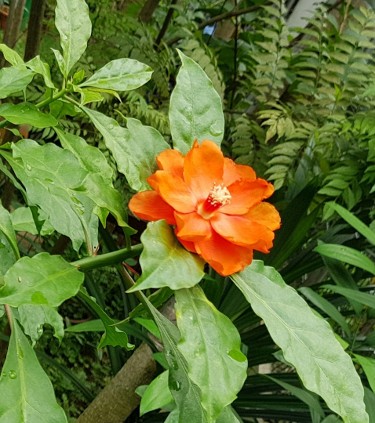Contents:
Common Names | Parts Usually Used | Plant(s) & Culture | Where Found | Medicinal Properties
Legends, Myths and Stories | Uses | Formulas or Dosages | Nutrient Content | Resource Links
Scientific Names

- Cactus bleo
- Leuenbergeria bleo
- Pereskia bleo
- Pereskia corrugata
- Pereskia panamensis
- Rhodocactus bleo
- Rhodocactus corrugatus
- Cactaceae family
Common Names
- Auguja de arra (Nicaragua)
- Bleo
- Bleo pereskia
- Bleo de chupa (Spanish)
- Butarrar (Kuna Indian)
- Cak Sing Cam (Chinese)
- Chat Sim Chan (Chinese)
- Chinese rose
- Chupa (Spanish)
- Chupa melón (Spanish)
- Clarol (Spanish)
- Jarum tujuh bilah (Malaysia)
- Jarum tujuh (Malaysia)
- Leaf cactus
- Najií (Spanish)
- Najii De Culebra (Panama)
- Najú de culebra (Spanish)
- Najú de esoubas (Spanish)
- Najú de espinas (Spanish)
- Orange rose cactus
- Pokok kanser (Malaysia)
- Perescia
- Péreskia bleo (French)
- Pipchuelo (Spanish)
- Pokok Jarum Tujuh Bilah (Malay)
- Qi xing zhen (Chinese)
- Rose cactus
- Rose-coloured Pereskia
- Seven Star Needle
- Spinach cactus
- Wax rose
Parts Usually Used
Most commonly the leaves, but also sometimes the fruit or flower
Back to Top
Description of Plant(s) and Culture
Pereskia bleo is an unusual form of cactus since it has leaves. It’s a shrubby, deciduous, tree-like plant that grows to 6-8 meters tall. The trunk has spines that are up to 1-2 cm long. red-orange flowers adorn this plant along with yelow, fleshy, thick-walled fruits that measure up to 5 cm in length and 6-8 mm in diameter.
Back to Top
Where Found
Pereskia bleo originates from Central America and Western South America but is now found in tropical and subtropical regions of the world.
Medicinal Properties
This plant has shown to have antiproliferative and cancer protective properties as well as antimicrobial, antiparasitic and antioxidant effects.
According to ResearchGate: In-vitro cytotoxicity screening and cytotoxic effects on cancer cell lines of P. bleo leaf had shown different findings from previous studies. For example, an early study by Tan found that methanol extract of P. bleo plant contains bioactive compound that is able to induce apoptosis in breast carcinoma. Similar findings from Sri Nurestri, Sim, Abdul Wahab and Yaacob and Sri Nurestri et al. showed that P. bleo contains natural constituents such as α-tocopherol, which possessed very remarkable cytotoxic activity against human nasopharyngeal epidermoid carcinoma cell line.
Legends, Myths and Stories
This plant is often used as a barrier hedge, since it has sharp spines and a strong stem.
It is also used as an insect repellant.
Back to Top
Uses
It is used traditionally as a dietary vegetable, water purifier, and insect repellant and for maintaining health, It is also used for treatment of hypertension, infections, detoxification, headache, ulcers, prevention of cancer, and/or treatment of cancer, hemorrhoids, stomach ache, muscle pain, diabetes, inflammation, asthma, dermatitis and rheumatism.
Some people use this plant to neutralize the effects of snakebites, although no scientific studies have been done to test the effectiveness of this.
People often eat the raw leaf, flower, or fruit for general health maintenance.
Formulas or Dosages
Treatment for cancer prevention and detoxification involves making tea by boiling the fruit and/or the leaves, then drinking it.
A daily drink for overall good health is made by juicing the leaves, then boiling with water.
Make a decoction using the leaves, then use as a warm bath to relieve muscle aches.
To treat boils, pound the leaves into a paste, then apply to the affected area.
Back to Top
Nutrient Content
Seven Star Needle is known to contain these minerals: carbon 50.6%, oxygen 35.4%, magnesium 0.4%, phosphorus 0.4%, sulfur 1.5%, chlorine 1.2%, potassium 10.2% and calcium 0.3%.
Resource Links
Recent Studies Show Seven Herbs Help Stop Cancer Growth
Futurity.org: These Medicinal Plants Put Brakes on Cancer Growth
National University of Singapore: Anti-cancer properties uncovered in plants
